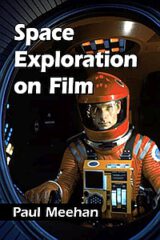With science-fiction movies as part of everyday film culture as stream, DVD or in theaters today, we may forget the humble beginnings of the genre, and with respect to countless technical obstacles of space missions could wonder how films, some almost a century ago, confronted these problems in their times.
 Paul Meehan’s title stresses “science over science fiction” ideas about space travel in his latest book, which means he highlights the more realistic and fact-based science fiction tales. As with most cinematic experiences and genres, space exploration also can look back on a history of important directors, set decorators and in this case, sometimes scientific and technical advisors. The films he selected provide an overview on how space exploration was encountered in film, or rather, how this enterprise could be done soon with technology currently in use, or may be available before long.
Paul Meehan’s title stresses “science over science fiction” ideas about space travel in his latest book, which means he highlights the more realistic and fact-based science fiction tales. As with most cinematic experiences and genres, space exploration also can look back on a history of important directors, set decorators and in this case, sometimes scientific and technical advisors. The films he selected provide an overview on how space exploration was encountered in film, or rather, how this enterprise could be done soon with technology currently in use, or may be available before long.
Several movies from diverse regions and decades will be examined closer. Some of them are “fact-based re-enactments of actual American and Russian space missions … and historical accounts of the development of space technology” that include Apollo 13, Gagarin First Man in Space, The Spacewalker, First Man, Salyut 7, Road to the Stars, I Aim at the Stars, The Right Stuff, October Sky, and Hidden Figures. Other titles that were speculative dramatizations done during the formative years of the space age, such as Destination Moon, Countdown, Marooned and Conquest of Space will also be under inspection.
After a decade of fresh and daring “rocket” film making in the 1920s and 30s, between the years 1937 and 1950, nothing of the sort took off. At that time, the science fiction genre – in films and novels – experienced some stagnation and any such film production was swiftly assimilated into the new and successful “horror film” genre. However, the mass of sci-fi films to come in the 1950s and 60s made up for that lack easily. These years would establish the genre with force.
Author Paul Meehan, who has published a number of titles on film and science fiction before, here compiled expert information on almost 80 space exploration movies, not to mention lots more that are referred to in passing. So be ready to encounter Moonraker, Discovery, The Andromeda Nebula, Armageddon, Deep Impact, Forbidden Planet, Silent Running, The Heavens Call, Meteor, Robinson Crusoe on Mars, several Star Trek movies, Alien, Things to Come, 2010: The Year We Make Contact, The Wandering Earth, When Worlds Collide, Europa Report, Road to the Stars, and other sci-fi classics again.
The nine chapters are loosely organized around themes such as visions of space travel before and after either Russian or American rockets took off, the huge impact of Kubrick’s 2001: A Space Odyssey, work and life in outer space or on distant planets, and the Apollo program and its effects on popular culture.
Furthermore, the sci-fi space exploration movies made in the US and the USSR (that often differed extremely), an extra chapter on Mars exploration and – maybe the most interesting section here – various dire threats to Earth coming from outer space, be they aliens or “planet killer” asteroids and the cinematic response to these.
The movies Interstellar, Contact and Passengers receive a lot of room at the end of the book. As some of their features and deeper studies of the physical forces are high hard science content. Naturally, they too, employ technology still unavailable to mankind, but considering sci-fi movie productions of the 1960s and their (partial) closeness to technological revolutions and inventions that would follow just a few years later, the three films may be on the right track, in a way. Moreover, even though a welcome requirement for interstellar travel, space journeys at a speed faster than light (light speed is approximately 186,000 miles per second) are missing from the film selection in these chapters entirely. Still, there is the “workaround” of comfortable travel by wormholes; a highly theoretical physical enigma, but useful as a tool to cover vast distances in sci-fi film. This, actually, is probably the better solution, as several creations of the 1960s did not even mention how their space vessels would navigate, accelerate or which technology fueled by what resource was in use.
With all the information on directors, and the vast amount of international productions that approached space travel in film over the decades, Space Exploration on Film is exhaustive and may be also able to explain a few questions even sci-fi film buffs may have held back for years. As not all movie plots are strictly logical or the fictional technology in use would be accepted without the slightest doubts. Even though, and that is one of the benefits of Meehan’s book, we learn about the many aerospace engineers, astronomers, scientific consultants and even former astronauts who provided knowledge and helped to embed a certain realism, sometimes right on the film set.
Review by Dr. A. Ebert © 2022
Paul Meehan. Space Exploration on Film. McFarland, 2022, 209 p.
